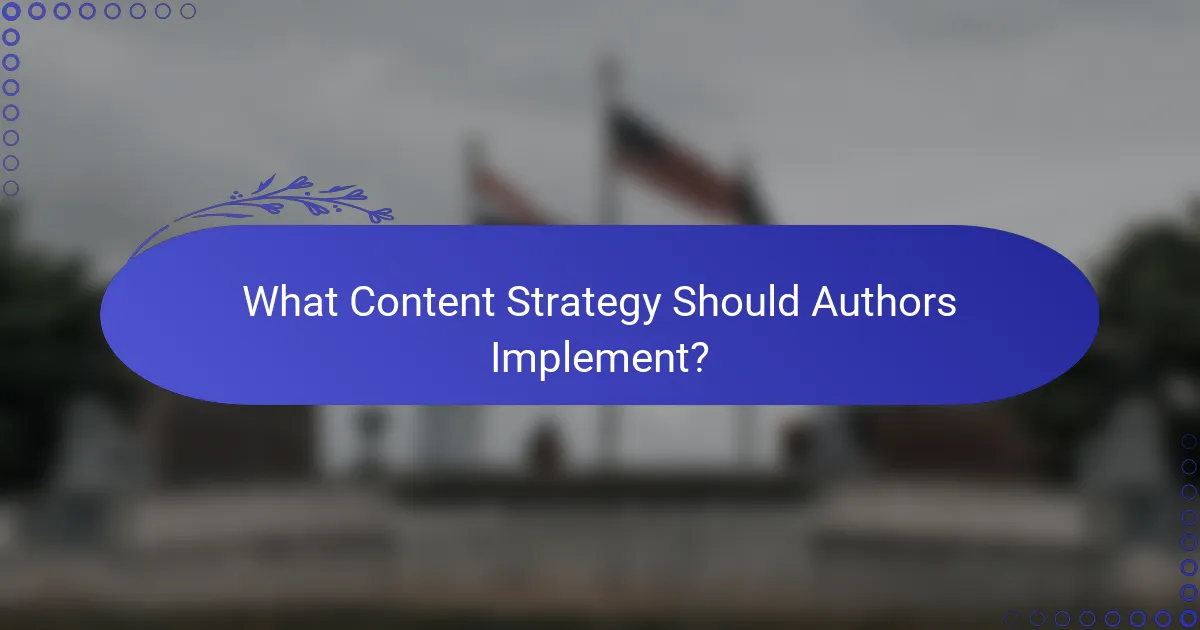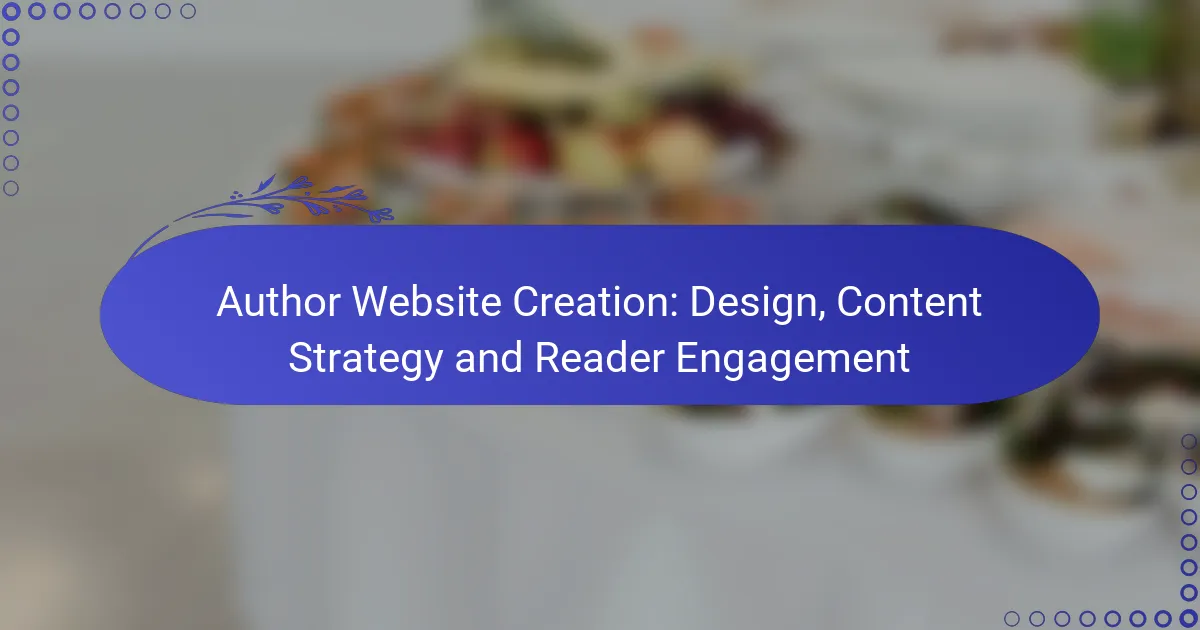Creating an effective author website requires a thoughtful approach to design and content strategy that prioritizes reader engagement. By focusing on intuitive navigation, responsive design, and strong visual branding, authors can create a seamless user experience that invites exploration. Additionally, a consistent content strategy that incorporates diverse formats and interactive features can help build a loyal readership and enhance visibility in a competitive landscape.

How to Design an Author Website for Reader Engagement?
To design an author website that effectively engages readers, focus on creating a seamless user experience that encourages exploration and interaction. Key elements include intuitive navigation, responsive design, strong visual branding, effective use of white space, and optimized loading speed.
User-Friendly Navigation
User-friendly navigation is crucial for keeping readers on your site. Ensure that your menu is clear and accessible, with categories that reflect your content, such as books, blog posts, and contact information. Consider using dropdown menus for subcategories to avoid clutter.
Limit the number of menu items to around five to seven main options to prevent overwhelming visitors. A search bar can also enhance navigation, allowing users to quickly find specific content.
Responsive Design Principles
Responsive design ensures your website looks good on all devices, from desktops to smartphones. Use flexible layouts and scalable images to adapt to different screen sizes, enhancing the user experience regardless of the device used.
Test your website on various devices and browsers to identify any layout issues. Aim for a mobile-first design approach, as a significant portion of web traffic comes from mobile devices.
Visual Branding Elements
Visual branding elements, such as your logo, color scheme, and typography, create a cohesive identity for your author website. Choose colors that reflect your genre and personality, and maintain consistency across all pages.
Incorporate high-quality images and graphics that resonate with your content. This can include book covers, author photos, or themed visuals that enhance the overall aesthetic and engage visitors.
Effective Use of White Space
Effective use of white space improves readability and helps guide the reader’s eye across your website. Avoid cluttered layouts by spacing out text and images, which allows for a more pleasant browsing experience.
Use margins and padding strategically to create a balanced look. Aim for a clean design that highlights your content rather than distracting from it.
Optimized Loading Speed
Optimized loading speed is essential for retaining visitors, as slow websites can lead to high bounce rates. Aim for a loading time of under three seconds by compressing images, minimizing code, and leveraging browser caching.
Regularly test your website’s speed using tools like Google PageSpeed Insights. Address any issues promptly to ensure a smooth experience for your readers, which can ultimately improve engagement and retention.

What Content Strategy Should Authors Implement?
Authors should develop a content strategy that focuses on consistency, audience engagement, and diverse formats. This approach helps build a loyal readership and enhances visibility in a crowded market.
Blogging Frequency and Consistency
Establishing a regular blogging schedule is crucial for maintaining reader interest. Aim for at least one post per week to keep your audience engaged, but ensure that the quality of content remains high. Consistency in posting helps build anticipation among readers.
Consider using a content calendar to plan topics and deadlines. This tool can help you maintain a steady flow of content while allowing for flexibility to address timely issues or trends in your genre.
SEO Best Practices for Authors
Implementing SEO best practices is essential for increasing your website’s visibility. Focus on keyword research to identify terms your target audience is searching for, and incorporate these keywords naturally into your content, titles, and meta descriptions.
Additionally, optimize your website’s loading speed and ensure it is mobile-friendly. These factors significantly impact user experience and search engine rankings, making them vital for attracting and retaining visitors.
Content Types: Articles, Videos, Podcasts
Diversifying content types can enhance engagement and reach different audience segments. In addition to written articles, consider creating videos or podcasts to cater to varying preferences. For example, a video summary of your latest book can attract visual learners, while a podcast interview can engage auditory audiences.
Each format has its strengths; articles are great for in-depth analysis, while videos can convey emotion and personality. Aim to mix these formats to keep your content fresh and appealing.
Utilizing Social Media for Content Promotion
Social media platforms are powerful tools for promoting your content and connecting with readers. Choose platforms that align with your audience, such as Instagram for visual content or Twitter for quick updates and interactions.
Engage with your audience by sharing snippets of your work, behind-the-scenes content, and personal insights. Regular interaction can foster a sense of community and encourage followers to share your content, amplifying your reach.

How to Enhance Reader Engagement on an Author Website?
Enhancing reader engagement on an author website involves creating interactive and valuable experiences that encourage visitors to connect with your content. By implementing features like polls, newsletters, and community sections, authors can foster a loyal readership and stimulate ongoing interaction.
Interactive Features: Polls and Quizzes
Polls and quizzes are effective tools for engaging readers by inviting them to share their opinions or test their knowledge. These interactive features can be easily integrated into your website using plugins or custom code, allowing readers to participate without leaving the page.
Consider using polls to gauge reader preferences on topics or book genres, while quizzes can be themed around your books or characters. This not only entertains but also provides insights into your audience’s interests, helping tailor future content.
Email Newsletter Sign-Ups
Email newsletters are a powerful way to keep readers informed and engaged with your work. By offering a simple sign-up form on your website, you can build a mailing list that allows you to share updates, exclusive content, and promotional offers directly with your audience.
To encourage sign-ups, consider offering a freebie, such as a short story or a sneak peek of your upcoming book. Ensure that your newsletter is visually appealing and provides value, as this will help maintain subscriber interest over time.
Comment Sections and Community Building
Implementing comment sections on your blog posts or book pages can significantly enhance reader engagement by fostering discussion. This allows readers to share their thoughts, ask questions, and connect with you and each other, creating a sense of community around your work.
Moderation is key to maintaining a positive environment. Set clear guidelines for comments and actively engage by responding to readers. This interaction can encourage more visitors to participate and feel valued in your community.
Exclusive Content for Subscribers
Offering exclusive content for subscribers can incentivize readers to join your mailing list or engage more deeply with your website. This could include behind-the-scenes looks at your writing process, early access to new releases, or special discounts on your books.
Make sure to promote this exclusive content prominently on your site. Clearly communicate the benefits of subscribing, and consider using a tiered approach where different levels of engagement yield different types of exclusive content, appealing to a wider audience.

What Are the Best Platforms for Author Websites?
The best platforms for author websites include WordPress, Wix, and Squarespace, each offering unique features tailored to different needs. Depending on your focus—customization, ease of use, or design aesthetics—you can choose the platform that best aligns with your goals.
WordPress for Customization
WordPress is renowned for its extensive customization options, making it ideal for authors who want a unique online presence. With thousands of themes and plugins available, you can tailor your site to reflect your brand and integrate various functionalities, such as e-commerce or membership features.
When using WordPress, consider whether you want a self-hosted site (WordPress.org) or a hosted solution (WordPress.com). Self-hosting offers greater flexibility but requires more technical knowledge, while hosted options simplify setup at the cost of some customization.
Wix for Ease of Use
Wix is a user-friendly platform that allows authors to create websites quickly without any coding skills. Its drag-and-drop interface makes it easy to design your site, and you can choose from a variety of templates specifically designed for authors and creatives.
While Wix is great for beginners, it has limitations in terms of scalability and advanced features. If you anticipate needing more complex functionalities in the future, weigh these factors before committing to this platform.
Squarespace for Aesthetic Appeal
Squarespace is known for its visually stunning templates, making it a popular choice for authors who prioritize design. The platform offers a range of elegant layouts that can enhance your portfolio and showcase your work beautifully.
However, while Squarespace excels in aesthetics, it may not provide as much flexibility in customization as WordPress. If you value a polished look and are willing to work within a more structured environment, Squarespace could be the right fit for your author website.

What Metrics Should Authors Track for Success?
Authors should track metrics such as website traffic, engagement rates, and conversion rates to gauge their success. These metrics provide insights into how well content resonates with readers and how effectively it drives desired actions.
Website Traffic Analysis
Website traffic analysis involves monitoring the number of visitors to an author’s site over time. Key metrics include unique visitors, page views, and session duration, which help identify trends and popular content. Tools like Google Analytics can provide detailed insights into traffic sources, such as organic search, social media, or referrals.
To improve traffic, authors should focus on search engine optimization (SEO) strategies, including keyword research and quality backlinks. Aiming for a steady increase in traffic, even by a few percentage points each month, can indicate successful outreach and content marketing efforts.
Engagement Rates on Content
Engagement rates measure how readers interact with an author’s content, including metrics like comments, shares, and time spent on pages. High engagement suggests that content resonates well with the audience, while low engagement may indicate a need for improvement in topics or presentation.
Authors can enhance engagement by encouraging comments and discussions, using compelling visuals, and incorporating calls-to-action. Tracking engagement over time can help identify which types of content generate the most interest, allowing authors to refine their strategies accordingly.
